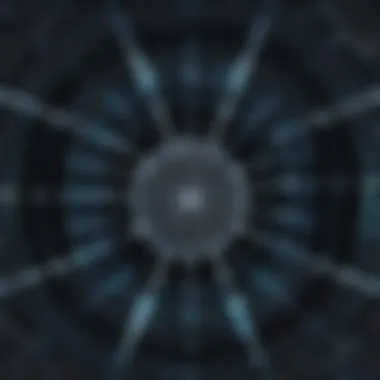Understanding the Dark Web: An In-Depth Exploration


Intro
The dark web is a complex and often misunderstood aspect of the internet. It exists parallel to the surface web we use daily. While the surface web contains widely accessible websites, the dark web remains hidden from standard search engines and requires specialized software for access. Understanding its structure, functionalities, and implications is crucial for navigating the digital landscape responsibly.
This article aims to shed light on the dark web’s intricacies. It delineates the differences between the surface web and the dark web, explores the technologies that enable its existence, and examines the motivations behind users' interest in this hidden segment. Moreover, it addresses the potential risks and ethical concerns associated with engaging in dark web activities. By the end of this exploration, readers will have a well-rounded understanding of this often mischaracterized online realm.
Prelims to the Dark Web
The dark web remains a topic of intrigue and concern for many. Understanding its complexities is essential in today’s digital landscape. This section serves as a foundational overview, focusing on the definitions and historical context of the dark web, which will aid readers in comprehending its broader implications as the article progresses.
Defining the Dark Web
The dark web refers to parts of the internet that are not indexed by traditional search engines. It is accessible only through specialized software, most commonly the Tor browser. Accessing the dark web allows users to maintain a level of anonymity. Users often seek this anonymity to participate in various activities, both legitimate and illicit. This aspect of the dark web fosters discussions around privacy, security, and the ethical consequences of engaging with such a hidden segment of the internet.
Furthermore, the dark web operates on a distinct infrastructure. Unlike the surface web, which consists of widely used websites, the dark web contains encrypted networks. These networks enhance user privacy but also create challenges for law enforcement. The duality of its existence raises questions about the balance between freedom and control in digital environments.
Historical Context
The historical context of the dark web is tied to the developments in internet privacy and security. Initially, the seeds of the dark web were planted in the 1990s with the advent of cryptographic tools. The creation of the Onion Router (Tor) in 2002 marked a substantial milestone. Tor was designed to protect users' anonymity online, primarily for political activists and individuals in repressive regimes.
As the dark web evolved, it attracted various user demographics. While it has been a haven for whistleblowers and activists, it is also linked to illegal activities such as drug trafficking and hacking services. The historical evolution showcases the challenges of regulating such a space. In many ways, the history of the dark web mirrors the ongoing debate about privacy rights versus public safety in the digital age.
The dark web’s dual nature encapsulates a significant paradox: it serves as both a refuge for those seeking privacy and a marketplace for illicit goods and services.
Through this exploration of definitions and historical context, readers can begin to understand the motivations and implications surrounding the dark web, setting the stage for deeper inquiry into its structure and functionalities.
The Structure of the Internet
Understanding the structure of the internet is essential for grasping the dynamics of the dark web. The internet is not a single entity; rather, it is a complex network composed of various layers that serve different purposes and functionalities. The surface web, deep web, and dark web form an integral hierarchy where each layer plays a specific role in how information is stored, accessed, and shared.
Surface Web
The surface web encompasses all parts of the internet that are indexed by standard search engines like Google, Bing, and Yahoo. It represents roughly 10-20% of the entire web. This section includes easily accessible websites, social media platforms, and e-commerce sites.
The content here is visible to the public, making it a popular space for businesses and social interactions. However, it also has limited anonymity, making it susceptible to data collection and surveillance.
Notable characteristics of the surface web include:
- Indexability: Easily searchable information using traditional search engines.
- Public Availability: The content is accessible to anyone with an internet connection.
- Limited Privacy: Users often share personal data, which can lead to privacy concerns.
Deep Web
The deep web consists of all online content that is not indexed by traditional search engines. It represents a significantly larger portion of the internet, estimated to be about 80-90% of the overall web.
This section includes databases, private corporate sites, medical records, and other data behind paywalls or forms. It plays a crucial role in protecting sensitive information and includes valuable resources that would otherwise be exposed to unwanted searches.
Key features of the deep web include:
- Access Control: Requires permission or specific credentials to access its content.
- Dynamic Content: Often contains information that changes frequently, making it challenging to index.
- Privacy Protections: Provides users control over their data and how it is shared.
Characteristics of the Dark Web


The dark web is a smaller segment hidden within the deep web. It requires special tools for access, primarily to maintain anonymity and privacy. This is where many illicit activities are identified, but it also serves legitimate purposes.
Some notable characteristics include:
- Anonymity: Users can navigate and engage without revealing their identity.
- Access through Specialized Tools: Browsers such as Tor, which obscures users' locations and usage, are needed.
- Decentralized Nature: Content is distributed across a network of nodes, making takedowns difficult.
Overall, the structure of the internet is foundational for understanding the dark web. Recognizing how the surface web and deep web function relative to the dark web allows for a deeper insight into how users engage with each layer, the risks involved, and the implications for privacy and security.
Accessing the Dark Web
Accessing the dark web is a pivotal topic in understanding its dynamics and implications. The dark web encompasses specific areas of the internet that require particular tools to access, distinguishing it from the more well-known surface web. Many individuals might wonder why they would need to explore this hidden layer of the digital realm. The motivations can range from a desire for privacy, to seeking information that is not available through regular search engines, or even engaging in illicit activities. This section aims to unpack the methods one can utilize to access the dark web while considering the associated benefits and risks.
Tools and Technologies
Tor Browser
The Tor Browser is perhaps the most recognized tool for accessing the dark web. It is designed to anonymize users' online activities by routing their internet connection through multiple servers around the globe. This specific aspect of Tor Browser highlights its importance as it helps to protect user identity. One key characteristic of the Tor Browser is its ability to reach .onion sites, which are accessible only through this browser. It is beneficial for users who prioritize privacy and resist surveillance. However, its unique feature of routing traffic through various nodes may lead to slower connections, posing a disadvantage for bandwidth-intensive activities. Despite this, Tor remains the go-to choice for both those seeking privacy and users who need access to dark web resources.
I2P
I2P, or Invisible Internet Project, serves as another tool for accessing the dark web, focusing on privacy and anonymity. Its contribution to the overall exploration of the dark web lies in its robust encryption that protects users’ data throughout their journey. A key characteristic of I2P is its peer-to-peer architecture, making it less centralized than Tor. For those who value decentralization, I2P might be a popular choice due to these features. A unique feature of I2P is its ability to support both anonymous browsing and the hosting of anonymous websites. However, the complexity of setup and a steeper learning curve may deter some novice users. The advantages of strong privacy come at the cost of accessibility, as entering some sites can be more challenging than on other platforms.
Navigating the Dark Web
Navigating the dark web requires a different approach compared to conventional internet browsing. It entails knowing how to find information and resources effectively within a maze of sites that are often unindexed by traditional search engines. Understanding this navigation can enhance users’ experiences while mitigating risks associated with exploring this hidden domain.
Search Engines
Search engines specifically built for the dark web, like DuckDuckGo and notEvil, play a critical role in navigating through it. They index .onion domains and assist users in finding content that would otherwise be difficult to locate. These search engines are beneficial because they allow users to explore this space without needing direct links to individual sites. However, the limited number of indexed pages means that searching can sometimes return incomplete results, restricting users from accessing the full breadth of available content. This aspect can frustrate users who rely heavily on exhaustive searches for information.
Directories
Directories on the dark web can be likened to a yellow pages of sorts for .onion sites. They provide organized lists of websites categorized by content and purpose. This organizing principle is beneficial because it provides a curated method for users to discover new resources without sifting through unindexed content. The unique feature of directories is that they often contain user-generated reviews or ratings, which can offer insights on site reliability. However, the risk is present that some directories may link to deceptive or harmful sites, calling for a cautious approach when using them.
Overall, accessing and navigating the dark web presents both opportunities and challenges. It is crucial for users to be informed and prepared as they venture into this complex digital landscape.
Content Found on the Dark Web
The dark web often conjures images of illicit activities and shadowy figures. However, the content found here is far more nuanced than commonly believed. Understanding what can be found in this elusive part of the internet is crucial. It enables a clear view of the motivations behind its usage. The dark web is a multifaceted environment where people engage in both legitimate and nefarious activities. Recognizing the balance between these can provide valuable insights into contemporary online behavior, privacy issues, and broader societal implications.
Legitimate Use Cases
Privacy and Anonymity
Privacy and anonymity are vital aspects of the dark web. Many users seek refuge from surveillance and intrusive data collection. This feature is particularly appealing in an age where personal information is often subjected to exploitation. The dark web offers platforms where individuals can express themselves without fear of judgement or repercussion. However, it's important to note that this anonymity can also attract those with malicious intent. This dual nature poses challenges.
Whistleblowing
Whistleblowing represents a critical use case related to the dark web. Individuals who expose unethical practices in organizations can utilize the dark web to protect their identity. The platforms available help ensure that sensitive information can be shared without facing severe consequences. The importance of protecting these whistleblowers cannot be understated as their actions can bring monumental changes in accountability. However, such protections are complex, often involving legal and ethical boundaries that are hard to navigate.
Freedom of Speech


Another legitimate use case is promoting freedom of speech. In countries with strict censorship laws, the dark web provides a vital outlet for individuals to voice their opinions. It offers sanctuary for dissidents, journalists, and activists. This is a fundamental right, yet the context of its application can be controversial. While fostering free expression is admirable, it may also facilitate harmful ideologies. Balancing these extremes continues to challenge policymakers.
Illicit Activities
Illegal Trade
Illegal trade is a prominent activity found on the dark web. Users often engage in the buying and selling of prohibited goods, like drugs, weapons, or stolen data. This aspect is one of the most cited when discussing the dark web. The anonymity that characterizes this area of the internet facilitates these transactions, making enforcement difficult for law agencies. The consequences, however, lead to real-world harm, raising concerns about regulation and moral implications.
Hacking Services
Hacking services represent another dark facet of the dark web. Individuals offering or seeking hacking services can often be found here. This includes a range of offerings from simple website defacements to extensive data breaches. The availability of these services presents a significant threat not just to personal security, but also to businesses and governments. The ease of access can lead to a normalization of cybercriminal behavior, complicating the landscape of cybersecurity.
Data Breaches
Data breaches are a critical concern in discussions about the dark web. Breached data often finds its way to dark web platforms, where it is sold or traded. The impact of these breaches can be devastating for individuals and organizations alike. With more data available, the risk of identity theft and financial fraud increases. Users must remain vigilant about their online presence, understanding the permanence of data that enters this environment.
It is essential to approach these topics with a balanced mindset. The dark web serves multiple purposes, and its implications reach both positive and negative spectrums.
Impact of the Dark Web on Society
The impact of the dark web on society is multifaceted, presenting both significant risks and intriguing benefits. Understanding these implications is essential for those who seek to navigate the complexities of Internet dynamics. The dark web, while often associated with criminal activities, also serves as a platform for privacy advocates and marginalized groups. Thus, its societal effects cannot simply be categorized as solely negative or solely positive.
Cybersecurity Threats
Cybersecurity threats emanating from the dark web pose serious challenges to individuals and organizations alike. Malicious actors exploit the anonymity provided by the dark web to plan and execute attacks, trade stolen data, and sell hacking tools.
Some notable threats include:
- Data Breaches: Cybercriminals can purchase stolen personal and financial information on dark web forums, leading to increased identity theft.
- Ransomware: Many ransomware groups operate from the dark web, selling their services to the highest bidder. This commodification of hacking creates widespread havoc for businesses.
- Phishing Schemes: The dark web hosts numerous platforms for sharing techniques and templates for effective phishing, thus exacerbating the threat landscape.
The prevalence of these threats requires a robust security posture from users and companies to mitigate incidents. Organizations need to invest in advanced threat detection systems and conduct regular training for employees to recognize signs of potential attacks.
"The dark web is more than just a haunt for criminals; it is an ecosystem fostering various activities, some beneficial and others harmful."
Law Enforcement Challenges
Law enforcement agencies face significant challenges when addressing crimes facilitated by the dark web. The primary difficulty lies in the anonymity that these online environments provide. Investigating criminal activities on the dark web is often akin to searching for a needle in a haystack.
Some challenges include:
- Jurisdictional Issues: The decentralized nature of the internet complicates legal jurisdiction. Criminals can operate in different countries, making prosecution a complex matter.
- Resource Allocation: Law enforcement agencies may struggle to allocate sufficient resources to investigate dark web activities adequately. As criminal methods evolve, so too must the strategies for detecting and combating them.
- Encryption Technologies: Many dark web services utilize robust encryption, making it difficult for agencies to monitor activities and trace malicious actors.
Law enforcement’s approach to these challenges includes partnerships with cybersecurity firms and international collaboration to share intelligence and resources. However, regulations and strategies must continuously adapt to keep pace with evolving threats.
The dark web's societal impact is a double-edged sword. It presents unique vulnerabilities that demand a well-coordinated response from both the public and private sectors.
Ethical Considerations
The topic of ethical considerations in the context of the dark web is essential for understanding its nuanced nature. The dark web is often portrayed merely as a hub for illegal activities. However, there are legitimate and critical discussions regarding the implications of privacy and security. As technology continues to evolve, users of the dark web must grapple with various moral dilemmas surrounding their anonymity and the role of government in regulating this space.
Moral Dilemmas


Anonymity vs. Accountability
Anonymity on the dark web presents a significant moral dilemma. On one hand, it allows users to engage freely without fear of retribution. This aspect is particularly relevant for whistleblowers, activists, or individuals seeking privacy from oppressive regimes. On the other hand, this lack of accountability can lead to harmful behavior, including illicit drug trades and cybercrimes.
The key characteristic of anonymity is that it enables people to express themselves without immediate societal consequences. This feature makes it a favorable option for many who seek safety and freedom of speech. However, one cannot ignore the disadvantages that anonymity presents. It often leads to a culture of recklessness, where illegal activities can thrive without direct consequences, posing risks not just to the individuals involved but to broader societal frameworks as well.
The Role of Government
The government plays a complex role in the dark web landscape. While it is tasked with ensuring safety and upholding law, its intervention often raises questions about privacy rights. The tension between maintaining security and preserving individual freedoms creates a unique environment where the government must navigate public interest and ethical obligations.
A key characteristic of government involvement is the attempt to regulate this part of the internet for public safety. However, this regulation can be seen as intrusive, compromising the very freedoms that are foundational to the internet's existence. The unique feature here is the balancing act between the need for security and the preservation of civil liberties.
Both advantages and disadvantages exist in the government's role. On one hand, effective regulation can mitigate harmful activities; on the other, heavy-handed approaches could infringe on personal freedoms.
Debate on Regulation
The debate surrounding regulation of the dark web remains highly contentious. Advocates for increased regulation argue that it could help curb illegal activities and promote a safer online environment. Others voice concerns that regulation could stifle freedom and anonymity, essential elements of the internet landscape.
This debate is not purely philosophical. Real-world implications affect content, users, and how the dark web evolves in the future. Understanding both sides of this discussion is crucial for anyone interested in the ethical implications of the dark web.
Future of the Dark Web
The future of the dark web is a crucial topic that reveals trends and implications for users and society. As technology advances, the dark web continues to evolve and shape the digital landscape. Increased awareness about privacy and secure communication is creating an environment where the dark web is viewed differently. While its reputation can seem overwhelming, it also serves as a refuge for those striving for anonymity or protection. Understanding future directions means being prepared for both risks and benefits.
Evolving Technologies
Technologies underpinning the dark web are changing continuously. Innovations in encryption and peer-to-peer networks enhance user privacy. These evolving technologies will likely lead to a more complex web structure, where identifying specific users becomes even more challenging.
Technologies like blockchain provide decentralized solutions for users to engage safely. The integration of advanced protocols will bolster security against potential breaches. As these technologies grow, the dark web may become less accessible for malicious entities, encouraging positive applications.
Potential Trends
The potential trends in the dark web suggest a significant shift in how users interact online. Key trends to explore include decentralization and enhanced privacy tools. Each trend has notable implications for the future.
Decentralization
Decentralization is gaining ground as a leading trend. Many users prefer decentralized platforms for a variety of reasons. It allows users to maintain control over their data and reduce reliance on single entities.
One key characteristic of decentralization is its ability to create a network free from censorship. This aspect benefits users seeking information without filtering or intrusion. However, while there are many advantages, a disadvantage can be the increased complexity of interfaces for users who are not familiar with such platforms.
Enhanced Privacy Tools
Enhanced privacy tools are also becoming more prevalent within the dark web. These tools cover a wide range of software and applications designed to protect user identity. A highlight of enhanced privacy tools is their ability to offer solutions such as anonymous browsing and secure messaging.
Users often find such tools beneficial as they facilitate safer communication in a world where surveillance is common. Nevertheless, there are concerns that particular privacy tools might be misused for illicit activities.
In summary, the future of the dark web is closely tied to the development of evolving technologies and potential trends. A greater understanding of these trends helps users navigate this complex digital space more securely.
Epilogue
In summarizing our exploration of the dark web, it is paramount to recognize its complex and dual nature. The dark web serves as both a shield for privacy advocates and a haven for illicit activities. As we have examined, this hidden layer of the internet offers significant implications for users and society at large. It is a space where anonymity can protect freedom of expression but also enable harmful behaviors.
Recap of Key Points
- The dark web is distinct from the surface and deep web, requiring specialized tools like the Tor Browser for access.
- Its content varies widely, with legitimate uses including privacy protection, whistleblowing, and forums for political activism.
- Conversely, the dark web is notorious for illegal activities, such as drug trafficking and hacking services.
- Cybersecurity threats arise from dark web activities, posing challenges not only for individuals but also for law enforcement agencies.
- Ethical dilemmas exist around anonymity, regulation, and the role of governments in monitoring these spaces.
Final Thoughts
The future of the dark web will likely be influenced by evolving technologies, with an increasing focus on decentralization and enhanced privacy tools. Understanding this nuanced environment is essential for any technology enthusiast or professional in the field. As we navigate this often misunderstood digital landscape, it is critical to maintain a balanced perspective, acknowledging both the potential benefits and the risks involved. Proper comprehension of these dynamics can empower users to make informed choices while participating in online activities.



